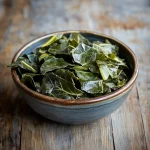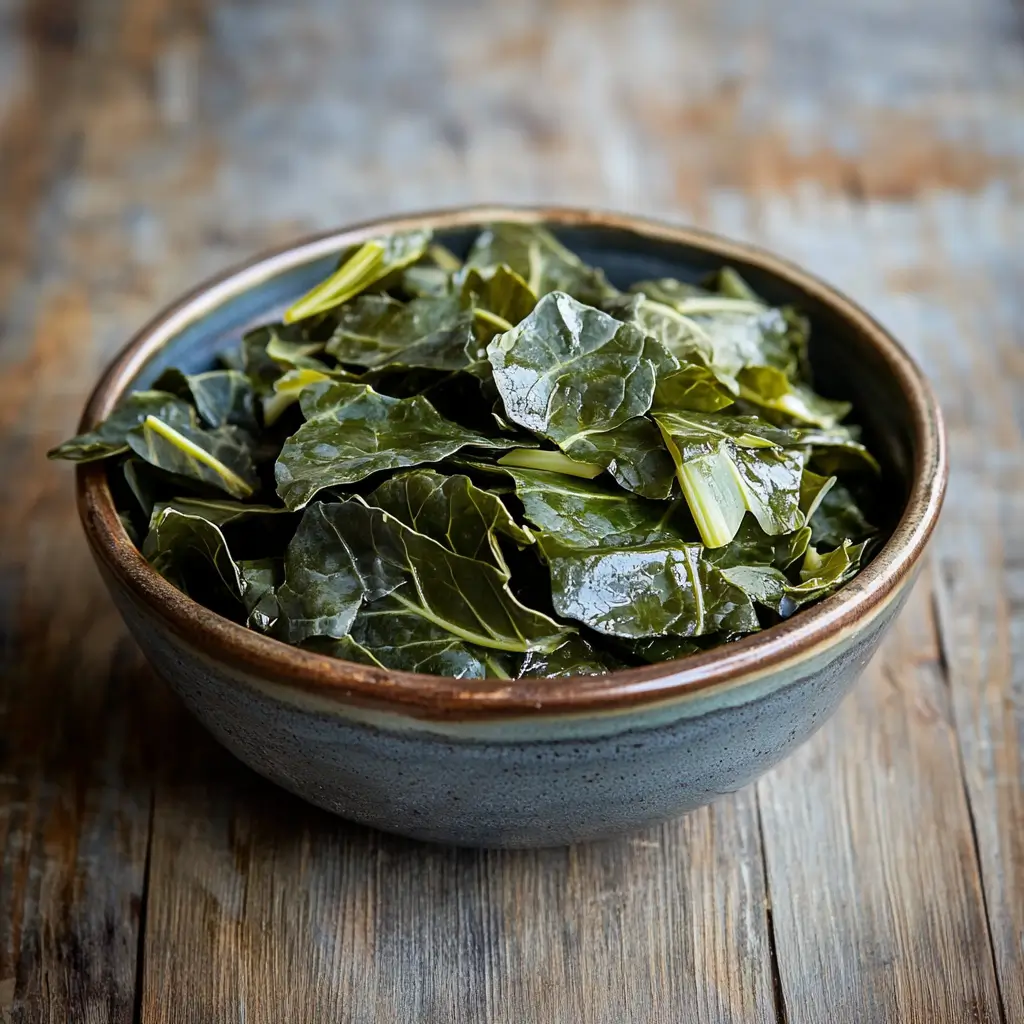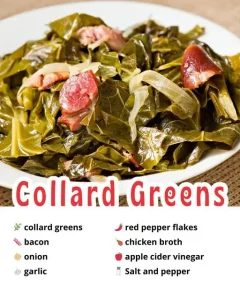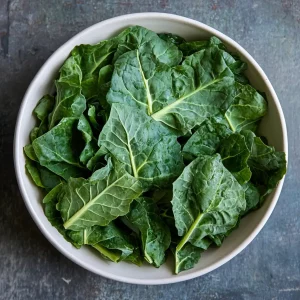Introduction about Collard Greens
Collard Greens also known as leafy cabbage, are a staple vegetable in many Southern cuisines. These large, dark green leaves are rich in vitamins, minerals, and fiber, making them a nutritious addition to any meal.
It have a slightly bitter taste, which mellows out when they are cooked slowly, often with smoked meats or flavorful seasonings. Traditionally, they are simmered in a broth or sautéed to bring out their earthy flavors, providing both a delicious side dish and a nutrient-dense component to a balanced diet.
Print
Collard Greens
- Total Time: 1 hour 10 minutes
- Yield: 6 servings
- Diet: Gluten Free
Description
A traditional Southern side dish, collard greens are slow-cooked until tender with flavorful ingredients like smoked meats, garlic, and onions. This dish is nutritious, packed with vitamins, and perfect for a hearty meal.
Ingredients
Instructions
Notes
For a vegetarian version, omit the ham hock and use vegetable broth. Serve with cornbread or rice for a complete meal.
- Prep Time: 10 minutes
- Cook Time: 60 minutes
- Category: Side Dish
- Method: Simmering
- Cuisine: Southern
Nutrition
- Calories: 150
- Sodium: 500mg
- Fat: 4g
- Carbohydrates: 10g
- Fiber: 5g
- Protein: 12g
Keywords: Leafy greens, Southern collard greens, Cooked greens
FAQs
- Can I make collard greens without meat?
Yes! For a vegetarian version, you can skip the ham hock and use vegetable broth for flavor. - How long do collard greens take to cook?
Collard greens typically take about 45-60 minutes to cook until they are tender and flavorful. - What can I serve with collard greens?
Collard greens pair well with cornbread, rice, or other Southern staples like black-eyed peas and fried chicken. - Can I use other greens in place of collard greens?
While collard greens have a unique flavor, you can substitute kale or mustard greens in a pinch, though the cooking times may vary. - Are collard greens healthy?
Absolutely! Collard greens are loaded with vitamins A, C, and K, as well as fiber and antioxidants, making them a nutritious addition to your meal.
Flavor
It not only versatile in terms of flavor but also in their culinary applications. They can be used as a wrap for fillings in place of tortillas or bread, added to soups and stews, or blended into smoothies for a nutrient boost.
The toughness of the leaves makes them perfect for slow cooking, as the longer they simmer, the more tender and flavorful they become. Whether prepared simply with garlic and oil or cooked with a rich broth, collard greens are a crowd-pleaser and a key element in Southern comfort food.
Historically, it have been a vital part of African American cuisine, often prepared with pork or ham hocks to add depth of flavor. They are usually served alongside cornbread, black-eyed peas, and other Southern staples, making them a beloved dish at family gatherings and holiday feasts.
Their rich cultural significance, combined with their health benefits, has helped it maintain a lasting presence in American cooking, particularly in the South, where they are considered a symbol of comfort and home.
In addition to their flavor, they packed with nutrients. They are an excellent source of vitamins A, C, and K, and are known for their anti-inflammatory properties. The high fiber content promotes digestive health, while the antioxidants found in the greens help protect the body against chronic diseases.
Calories
They are also low in calories and high in water content, making them a perfect choice for those looking to maintain a healthy diet while still enjoying a flavorful dish.
They can be enjoyed in a variety of ways, depending on the desired flavor and texture. Some prefer them soft and tender after a long simmer, while others like them sautéed quickly to preserve their slight bitterness and crunch.
No matter how they are prepared, They are a versatile vegetable that can enhance the nutritional value and flavor profile of any meal, making them a staple ingredient in kitchens across the world.
Nutritional Benefits of Collard Greens
They are known for their impressive nutritional profile, which includes a variety of vitamins and minerals essential for good health. They are particularly high in vitamins A, C, and K, which play important roles in immune function, skin health, and bone strength. One serving of them can provide more than the daily recommended intake of vitamin K, a nutrient that supports bone density and helps with blood clotting.
This makes them an important food for those looking to maintain strong bones and a healthy cardiovascular system.
Minerals
In addition to vitamins, they are also rich in minerals like calcium, iron, and magnesium. These nutrients are essential for maintaining strong bones, carrying oxygen through the blood, and supporting muscle and nerve function.
Collard greens are especially beneficial for those who follow a plant-based diet, as they provide a significant amount of calcium and iron, nutrients that are commonly associated with animal products. This makes collard greens a valuable addition to vegetarian and vegan meals.
Another key benefit of collard greens is their high fiber content. Fiber is crucial for maintaining healthy digestion and can help prevent constipation and other digestive issues. It also helps regulate blood sugar levels and supports heart health by lowering cholesterol levels.
Diet
Including collard greens in your diet can contribute to a feeling of fullness, which can aid in weight management and promote overall health.
Collard greens also contain antioxidants, which help protect the body from oxidative stress and inflammation. These antioxidants, such as beta-carotene and flavonoids, have been shown to reduce the risk of chronic diseases like heart disease, diabetes, and certain types of cancer.
The anti-inflammatory properties of collard greens can also help alleviate symptoms of arthritis and other inflammatory conditions, making them a great choice for those looking to reduce inflammation in their diet.
Lastly, collard greens are low in calories and high in water content, making them an ideal food for those trying to lose weight or maintain a healthy lifestyle.
Their low-calorie density means that you can eat a large portion of collard greens without consuming too many calories, helping you feel full and satisfied while still staying within your calorie goals. This makes collard greens a perfect choice for anyone looking to enjoy a nutritious, low-calorie meal that’s packed with flavor and health benefits.
Traditional Cooking Methods about Collard Greens
The traditional preparation of collard greens often involves slow-cooking them with flavorful meats and seasonings to bring out their natural richness. One of the most popular ways to cook collard greens is by simmering them in a pot with smoked meats like ham hocks, bacon, or turkey wings.
The fat from the meat infuses the greens with a smoky, savory flavor, while the long cooking time allows the leaves to become tender and absorb the surrounding flavors. This method of preparation is a staple in Southern cuisine and is often served alongside cornbread or rice.
Vegetarian or vegan style
Collard greens can also be prepared in a vegetarian or vegan style by simmering them in a flavorful broth made from vegetable stock, garlic, onions, and spices.
This method highlights the natural taste of the greens while still providing a savory, satisfying dish. To enhance the flavor, some cooks add ingredients like apple cider vinegar, hot sauce, or red pepper flakes for a bit of acidity and heat. These additions help balance the bitterness of the greens and create a well-rounded dish that pairs well with a variety of side dishes.
In addition to simmering, collard greens can also be sautéed for a quicker, lighter preparation. Sautéing the greens in olive oil with garlic and onions allows them to retain some of their crunch while still softening enough to be enjoyable.
This method is perfect for those who prefer their greens to have a bit more texture and bite. Sautéed collard greens can be served as a side dish, tossed into pasta, or used as a filling for wraps or sandwiches.
Modern approach to cooking collard greens
Another modern approach to cooking collard greens is to use them in soups and stews. Collard greens add a hearty, nutritious element to any soup, and their sturdy texture holds up well during the cooking process.
They can be added to vegetable soups, bean stews, or even blended into creamy soups for a boost of flavor and nutrients. This versatility makes collard greens an excellent addition to a wide range of dishes, providing both nutrition and flavor.
No matter how they are prepared, collard greens are a beloved vegetable in many cultures, particularly in the American South. Whether you’re enjoying them as a classic Southern side dish, a modern sautéed accompaniment, or a nutritious addition to a soup, collard greens bring a unique flavor and texture to the table that is hard to replicate with other vegetables.
Modern Cuisine about Collard Greens
While they are often associated with traditional Southern cooking, they have found a place in modern cuisine as well. Chefs and home cooks alike are discovering new ways to incorporate them into a variety of dishes, from salads to smoothies. In recent years, there has been a growing trend of using them as a healthy alternative to tortillas or wraps.
Their large, sturdy leaves make them perfect for wrapping around fillings like grilled chicken, vegetables, or hummus, offering a low-carb, gluten-free option for those looking to reduce their carbohydrate intake.
Salads or slaws
Collard greens are also increasingly being used in raw preparations, such as salads or slaws. When thinly sliced, collard greens provide a crunchy, slightly bitter base that pairs well with tangy dressings and fresh vegetables.
They can be massaged with olive oil and lemon juice to soften the leaves and make them more palatable in raw dishes. This preparation method allows the greens to retain all of their nutrients while offering a refreshing, crunchy texture that complements a wide range of ingredients.
In the realm of smoothies and juices, collard greens are often blended with fruits and other leafy greens to create nutrient-packed beverages. Their mild bitterness is balanced by the sweetness of fruits like pineapple, apple, or mango, resulting in a drink that is both healthy and delicious.
Adding collard greens to your smoothie is an easy way to increase your intake of vitamins and minerals without sacrificing flavor. This versatility makes collard greens a popular choice for those looking to boost their daily nutrition.
Collard greens are also being used in creative ways in restaurants and gourmet kitchens. Chefs are incorporating them into dishes like collard green chips, where the leaves are baked or fried until crispy and seasoned with spices.
This turns the greens into a crunchy, flavorful snack that rivals traditional potato chips in taste but offers a much healthier alternative. Other innovative dishes include collard green pesto, where the greens are blended with garlic, olive oil, and nuts to create a vibrant, flavorful sauce for pasta or sandwiches.
Health benefits
As they continue to gain popularity in modern cuisine, their versatility and health benefits make them an appealing ingredient for a wide range of dishes.
Whether you’re looking to incorporate them into traditional recipes or experiment with new cooking methods, they offer a unique flavor and texture that can enhance any meal.
From wraps and salads to chips and smoothies, this leafy green has cemented its place in the kitchens of health-conscious cooks around the world.
Health and Cultural Significance
The recipe hold a special place in the culinary traditions of many cultures, particularly in the Southern United States. Their significance goes beyond just their flavor; they are often associated with family, heritage, and resilience. For many African American families, they represent a link to the past, with recipes passed down through generations. They are a symbol of comfort and together.
Conclusion
They are a flavorful and nutritious side dish that can be enjoyed in various ways. Whether slow-cooked with smoked meats or prepared in a lighter, vegetarian style, they offer a rich, savory taste that pairs beautifully with Southern staples.
Packed with vitamins and fiber, they are a delicious and healthy addition to any meal, perfect for both casual dinners and festive gatherings.





